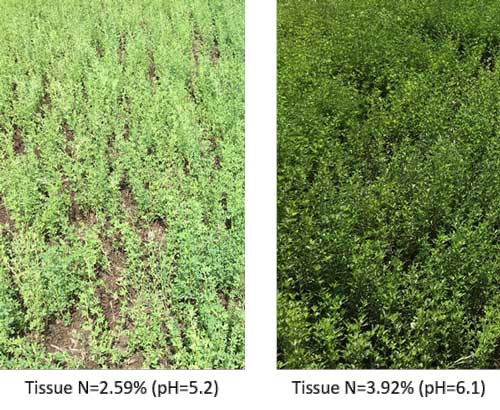Correcting acidic soil conditions through the application of lime can have a significant impact on crop yields, especially for alfalfa. Acidic soils can significantly reduce nodule establishment and activity in alfalfa, affecting nitrogen status and overall nutrient and water uptake (Figure 1). Since seeding alfalfa is expensive and a stand is expected to last for several years, getting lime applied and acidity corrected before seeding is critical. Liming is one of the most essential, but often overlooked, management decisions a producer can make for alfalfa production.
Unfortunately, lime is not always available in close proximity to where it may be needed. In many cases, trucking and spreading costs may be more than the cost of the lime itself. Lime quality can also vary widely and no one wants to apply more than is necessary. To make the best decisions on how much and what kind of lime to apply, it is useful to know how lime recommendations are made.

Figure 1. Soil pH affects nodule formation and activity for N fixation in alfalfa, in addition to nutrient availability and uptake. Photo by Dorivar Ruiz Diaz, K-State Research and Extension.
K-State lime recommendations
A routine soil test will measure the pH of the soil, and this will determine whether lime is needed on the field. Generally, east of the Flint Hills, lime is recommended for alfalfa if the pH drops below 6.4, with a target pH for liming of 6.8. In the Flint Hills and west, lime is recommended for alfalfa and all other crops when the pH drops below 5.8, with a target pH of 6.0. The target pH is simply the pH goal once the lime reacts with the soil.
Why is the target pH different for the two areas of Kansas?
The target pH values differ because of the pH of the subsoil. East of the Flint Hills, especially south of the Kansas River, the subsoil tends to be more acidic. A higher target pH is used to assure adequate pH conditions in the root zone, and provide sufficient amounts of calcium and magnesium. From the Flint Hills and west, most soils have high pH (basic) subsoils that can provide calcium and magnesium to meet crop needs.
Determining the soil pH is the first step in determining if lime is needed. However, it does not tell you the amount of lime you need to apply. Soils with more clay and organic matter will have more acidity at a given pH, and will require more lime/ECC (effective calcium carbonate) to reach a target soil pH than will a sandy soil. This is why two soils may have the same soil pH but have different lime requirements.
Calculating lime rates
Lime rates are given in pounds of effective calcium carbonate (ECC) per acre. How does that relate to agricultural lime and how much lime to apply? Lime materials can vary widely in their neutralizing power. All lime materials sold in Kansas must guarantee their ECC content and dealers are subject to inspection by the Kansas Department of Agriculture.
The two factors that influence the neutralizing value of aglime are the chemical neutralizing value of the lime material relative to pure calcium carbonate, and the fineness of crushing, or particle size, of the product. The finer the lime is ground, the greater the surface area of the product, the faster it will react, and the faster the acid neutralization will occur. These two factors are used in the determination of ECC. Expressing recommendations as pounds of ECC allows fine-tuning of rates for variation in lime sources, and avoids under- or over-applying lime products.
Lime sources
Research has clearly shown that a pound of ECC from agricultural lime, pelletized lime, water treatment plant sludge, fluid lime, or other sources is equal in neutralizing soil acidity. Therefore, under most circumstances, the cost per pound of ECC applied to your field should be a primary factor in source selection. Other factors such as rate of reaction (fineness), uniformity of spreading, and availability should be considered, but the final pH change, and subsequent alfalfa growth, will depend on the amount of ECC applied.
Application methods
All lime sources have a very limited solubility. When planting alfalfa, the best performance occurs when lime is incorporated and given time to react with and neutralize the acidity in the soil. When surface-applied and not incorporated, as in no-till systems, the reaction of lime is generally limited to only neutralizing the acidity and raising the pH in the top 2 to 3 inches of soil. Surface applications are sufficient in slightly acidic soils, but may not provide as good a soil environment for nodulation and nitrogen fixation in the extremely acid soils.
In no-till or reduced-till systems, where no incorporation of lime is planned, lower rates of lime application are normally recommended to avoid over-liming and raising the pH higher than needed in the surface 2-3 inches of soil. Over-liming can also reduce the availability of micronutrients such as zinc, iron, and manganese, and trigger deficiencies in some soils. Current K-State lime recommendations suggest that “traditional” rates designed for incorporation and mixing with the top 6 inches of soil should be reduced by 50 percent when surface-applied in no-till systems, or when applied to existing grass or alfalfa stands.
What about the calcium and magnesium contents?
Most agricultural limes found in Kansas contain both calcium and magnesium, with calcium exceeding magnesium. The exact ratio of these two essential plant nutrients will vary widely. Dolomitic lime (magnesium-containing) and calcitic lime (low-magnesium, high-calcium) provide similar benefits for most Kansas soils.
For more information, see K-State publication Soil Test Interpretations and Fertilizer Recommendations, MF-2586: http://www.bookstore.ksre.ksu.edu/pubs/MF2586.pdf
Dorivar Ruiz Diaz, Soil Fertility Specialist
ruizdiaz@ksu.edu
Tags: alfalfa lime application soil pH